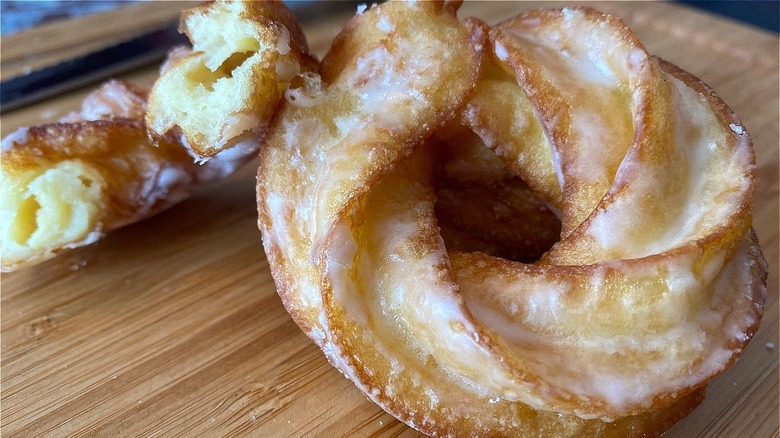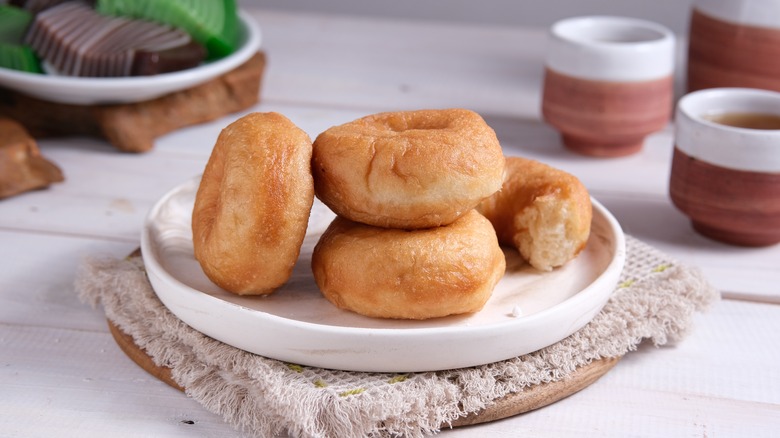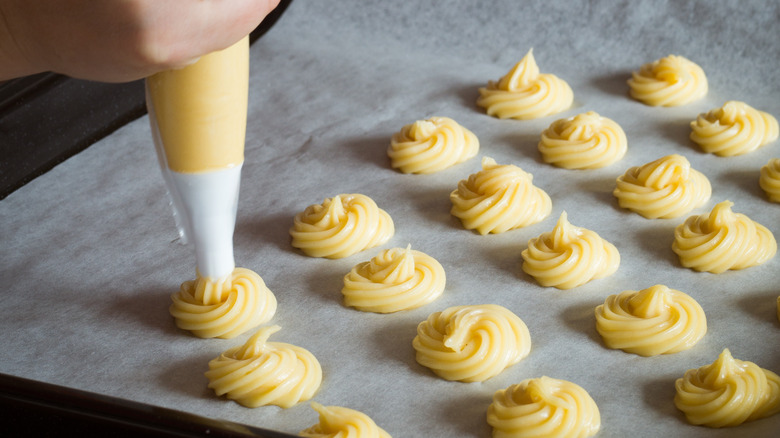Donuts Vs Chouxnuts: What's The Difference?
Few pastries are as recognizable in America as the classic glazed donut. In fact, the word "donut" itself has even come to have many more meanings besides the food, from shapes to car maneuvers to cheeky insults. Absolutely none of this can be said about the chouxnut.
Chouxnuts — pronounced "shoe-nuts" — are relative newcomers to the pastry scene, clocking in among the ever-increasing number of hybrid desserts with names inspired by established classics. You may have already encountered a number of hybrid pastries like cronuts, donut-muffins, or (sigh) cragels, which are all relatively easy to understand by name alone. Chouxnuts, on the other hand, might be a little harder to imagine for those unfamiliar with French pastry culture.
The essential difference between donuts and chouxnuts is in the dough. Both are round, both are fried, and both are fully stuffable, but donuts and chouxnuts have very different textures and appearances — and that all comes down to the types of dough they are made from. Classic glazed donuts are made from dough that is yeast-raised, which gives it its signature volume and airiness. Chouxnuts on the other hand, use pâte à choux, or choux pastry to achieve their unique look and texture. Does this use of choux pastry result in a deep-fried confection that warrants a seat in the pantheon of great sugary snacks? Let's find out.
A closer look at donuts
To really understand the differences and similarities between donuts and chouxnuts, it's essential to drill down into the makeup of each pastry. The first donuts came in the form of olykoeks, which were simple sweetened cakes fried in fat introduced to America by Dutch immigrants in the 18th century. Eventually, someone had the bright idea to punch out the center of the dough to prevent undercooking, and the modern donut was born.
Donuts nowadays come in many shapes, sizes, and types, and that's largely in part to their irresistible pillowy texture. This airiness is achievable thanks to the essential ingredients of the dough, which include flour, milk, sugar, eggs, and the star of the show: yeast! Yeast is what transforms an otherwise dense lump of bread into a soft, squishy donut, and it's all thanks to the gas it produces as it consumes the sugars present in the dough. After having ample time to rise, the dough gets cut and rolled into the desired shape, and then fried on all sides in hot oil.
Once they're fried, donuts are one of the great blank canvases for bakers to decorate. They can be glazed, dusted with sugar, adorned with strips of bacon, and even stuffed with jelly or custard thanks to the pliability of the airy dough. It's important to note that stuffed varietals like malasadas are typically made with no hole punched out to maintain structural integrity when being filled.
Understanding chouxnuts and how they're made
If you think you've never tried choux pastry before, you may not realize it can be found in other common confections like eclairs, cream puffs, and churros. Choux pastry traditionally requires more finesse to make successfully than simple yeast-risen dough. It contains many of the same ingredients, like water, flour, eggs, and sugar, but temperature control is a vital component of the dough-mixing process. Because choux doesn't contain yeast, the dough relies on heat to allow the pastry to rise. However, bakers must be mindful of the batter's temperature when mixing the beaten eggs in — if the batter is too hot, the egg could cook prematurely which will prevent rise and result in flat chouxnuts.
When the choux pastry is ready, it then gets piped into donut rings on baking paper to get ready for cooking. Deep frying then creates the rise and slight puffiness from the heat, leaving ample space in the center for a filling. The outer dough's slight firmness allows it to hold the filling more reliably, even in ring form, which is why you're likely to see stuffed chouxnuts in bakeries that sell them. Chouxnuts also have a crispier texture than yeast donuts, which contrasts well with a cool, creamy filling. The French may have been enjoying chouxnuts in the form of crullers for centuries, but this treat is now starting to earn its seat at the table of great American confections.


